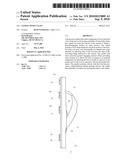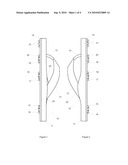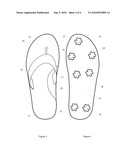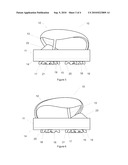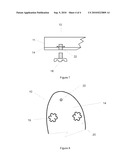Patent application title: Sandal with Cleats
Inventors:
David Neil Hensch (Calgary, CA)
IPC8 Class: AA43B312FI
USPC Class:
36 115
Class name: Boots, shoes, and leggings boots and shoes sandals
Publication date: 2010-09-09
Patent application number: 20100223809
cleats comprising of a foot-bed with a foot
strap and a sole having a plurality of removable cleats that extend out
from the bottom of the outsole to define a ground-engaging surface for
extra traction. The sandal includes a foot-strap attached to the front
portion of the foot-bed with a toe post, and substantially arc-shaped
side straps attached on opposing sides of the foot-bed, the ends of the
foot-strap being anchored to the outsole. The sandal with cleats provides
ground engaging traction while providing extra comfort as it allows the
foot to remain at an ambient temperature by allowing the foot to breath
in open air as the greater part of the foot is exposed to the
environmental elements. The sandal conforms closely with the foot that
provides a stable platform during sporting activity. The sandal has a
plurality of sockets for securing the cleats to the sandal.Claims:
1. A thong style sandal, comprising:a sole with embedded sockets for a
plurality of removable cleats;a substantially arc-shaped front foot strap
positioned on opposing lateral sides of the foot-bed, the ends of said
foot strap being anchored to said outsole;a toe post positioned on the
front part of the foot-bed, the ends of said toe post being anchored to
the foot strap and the outsole;a foot-bed.
2. The sandal of claim 1 wherein the sole contains the cleats that detachably secure into the socket, the cleats extend out of the sole for gripping the surface upon which the wearer walks, the cleats are removable for when not in use by the preferred use of sporting activity, the cleats are removable to allow the user to change the cleats to achieve the best traction.
3. The sandal of claim 1 wherein the cleat socket is permanently embedded into the sole of the sandal and is surrounded by the outsole material.Description:
CROSS-REFERENCE TO RELATED APPLICATIONS
[0001]This application claims the benefit of provisional patent application Ser. No. 61/209,151, filed 2009 Mar. 5 by the present inventor.
FEDERALLY SPONSORED RESEARCH
[0002]None.
SEQUENCE LISTING OR PROGRAM
[0003]Not Applicable.
BACKGROUND
[0004]1. Field of Invention
[0005]This invention generally relates to footwear, specifically to a thong style sandal with removable cleats for use in sporting activity where extra traction is necessary.
[0006]2. Prior Art
[0007]Sandals constitute one of the earliest footwear known to man. Typically, sandals incorporate either a leather or rubberized sole which can be attached to the human foot by straps extending across the Achilles heel, and the top of the foot of the user. Early sandals were designed for walking. Sandals however, have recently developed for more demanding sporting activities. More force and stress is applied to the sole, during the stopping and twisting moves during sports activities such as golf, hiking, climbing, etc.
[0008]Due to the recent commercial interest in sport sandals, there has become a need for a thong style sandal that is already familiar to the user that enhances the users ground stability by providing interchangeable cleats without sacrificing comfort.
[0009]Several types of sandals with cleats have been proposed but none currently reflect a thong type sandal with removable cleats--for example, in the following United States of America patents:
[0010]U.S. Pat. No. 7,584,553
[0011]U.S. Pat. No. 6,295,742
[0012]U.S. Pat. No. 2,525,308
[0013]U.S. Pat. No. 4,051,610
[0014]U.S. Pat. No. 4,525,939
[0015]U.S. Pat. No. 3,597,863
[0016]U.S. Pat. No. 6,052,920
[0017]U.S. Patent D379709
[0018]U.S. Patent D477129
[0019]U.S. Patent D496523
[0020]Although such sandals have achieved considerable popularity and commercial success, there has been a continuing need for improvement. and nevertheless all the sandals heretofore known suffer from a number of disadvantages: [0021](a) Some current types of sandals have permanent molded in traction enhancing features, which really don't add much more than a typical sandal sole. Any sole with a semi aggressive groove tread pattern will have the same stability effect. [0022](b) Some current types of sandals that do have the removable cleats are basically just a running shoe with holes cut out of the shoe upper. [0023](c) With not having removable cleats you are hoping the elemental conditions do not wear down the sole. The sole is will eventually wear down over time, and not having the ability to change and always have new cleats will lead to a loss of traction which defeats the purpose of the current types of sandals. Golf shoes have removable spikes for a reason it is so they can always be replaced ensuring proper traction on-going. [0024](d) The current types of sandals are only a one purpose use and cannot be altered to fit different applications or activities. Meaning you cannot change the use from golf cleats to hiking cleats to no cleats for everyday walking. [0025](e) The current types of sandals are one dimensional and only fit one type of individual's style preference not allowing another person to have a choice of a casual footwear product to compliment an individual style. [0026](f) Some traction enhancing systems are required to be strapped to your foot or a shoe making it very heavy and difficult to move.
SUMMARY
[0027]The invention, an improved thong style sandal that provides comfort and stability, has a foot-bed, a thong foot-strap attached to the front portion of the foot-bed, side straps attached to the thong and to the opposite sides of the rear portion of the foot-bed, a toe post between the Hallux (Big toe) and the index toe and an outsole comprised of a plurality of cleats that mount into receiving sockets that allow the user to easily, and when necessary change the cleats. The cleat sockets are placed around the perimeter of the outsole and form a preferable cleat pattern, a cleat then may be mounted into the cleat socket. The cleat socket is embedded into the sole and is surrounded by the outsole and foot bed material not allowing it to be removed from the sandal. The cleat socket is a permanent part of the sandal and the socket shape may be changed to accommodate different cleat mounting types.
[0028]Accordingly several advantages of the invention are to provide an improved thong style sandal, to provide means of greater comfort, ground engaging traction, a better form of foot temperature control, ability to remove the cleats for use in everyday situations, and better terrain feel. By not having the foot fully incased with an Achilles heel strap it allows the user to maintain a means of control during sporting activity. Still further objects and advantages will become apparent from a study of the following description and accompanying drawings.
DRAWINGS
[0029]Figures
[0030]FIG. 1 is a perspective left side view of a sandal constructed in accordance with the invention.
[0031]FIG. 2 is a perspective right side view of the sandal of FIG. 1.
[0032]FIG. 3 is a perspective top view.
[0033]FIG. 4 is a perspective bottom view.
[0034]FIG. 5 is a perspective front view of the sandal of FIGS. 1 and 2.
[0035]FIG. 6 is a perspective back view of the sandal of FIGS. 1 and 2.
[0036]FIG. 7 is a perspective view of the cleat socket.
[0037]FIG. 8 is a perspective bottom view of the socket with cleat removed
DRAWINGS
[0038]Reference Numerals [0039]10 sandal [0040]11 foot-bed [0041]12 foot strap [0042]13 toe post [0043]14 out sole [0044]15 cleat [0045]16 cleat [0046]17 cleat [0047]18 cleat [0048]19 cleat [0049]20 cleat [0050]21 cleat [0051]22 cleat socket [0052]23 arch support
DETAILED DESCRIPTION
Preferred Embodiment
[0053]FIG. 1 is a perspective left-side view taken from the user sandal 10 constructed in accordance with the invention. The view shows the foot strap 12 attached to the toe-post 13 mounted at two points of the foot-bed 11 and the seven visible mounted cleats 15, 16, 17, 18, 19, 20 and 21 on the outsole 14 and the preferable arch support 23.
[0054]FIG. 2 is a perspective right-side view of the sandal 10, showing the foot strap 12, the toe-post 13 mounted at two points to the foot-bed 11 with a preferable arch support 23 and the seven visible mounted cleats 15, 16, 17, 18, 19, 20 and 21 on the outsole 14.
[0055]FIG. 3 is a perspective top view of the sandal 10, showing the foot strap 12, the toe-post 13 mounted at three points of the foot-bed 11 and the preferable arch support 23.
[0056]FIG. 4 is a perspective bottom view of the sandal 10, showing preferable seven mounted cleats 15, 16, 17, 18, 19, 20 and 21 pattern on the outsole 14.
[0057]FIG. 5 is a perspective front view of the sandal 10, showing the foot strap 12, the toe-post 13 mounted at three points to the foot-bed 11 with the preferable arch support 23 and the seven visible mounted cleats 15, 16, 17, 18, 19, 20 and 21 on the outsole 14.
[0058]FIG. 6 is a perspective back view of the sandal 10, showing the foot strap 12, the toe-post 13 mounted at three points to the foot-bed 11 with the preferable arch support 23 and the seven visible mounted cleats 15, 16, 17, 18, 19, 20, and 21 on the outsole 14.
[0059]FIG. 7 is a lateral cross section view of the sandal 10, showing the cleat socket 22 molded in the outsole 14 and foot-bed 11 and cleat 18 not mounted in the cleat socket.
[0060]FIG. 8 is a cross section view of the front bottom portion of the sandal 10, showing the outsole 14 with a cleat socket 22 and cleats 17 and 19 mounted in the cleat sockets to the outsole.
[0061]Operation
[0062]In operation the user places the left or right foot sandal on the appropriate human foot with the toe post between the Hallux (Big toe) and the index toe. When the user steps into the sandal and places their foot onto the foot-bed the sole is engaged to the ground. As the weight of the stationary human body and the forces of gravity is initiated the cleats firmly grip the ground surface and provide a stable planting that prevents sliding or twisting of the sole during the activity. When not using the sandal during an activity the cleats do not fully engage as the human body's weight is not fully planted allowing the cleats solely to provide extra traction while walking on the ground surface.
Claims:
1. A thong style sandal, comprising:a sole with embedded sockets for a
plurality of removable cleats;a substantially arc-shaped front foot strap
positioned on opposing lateral sides of the foot-bed, the ends of said
foot strap being anchored to said outsole;a toe post positioned on the
front part of the foot-bed, the ends of said toe post being anchored to
the foot strap and the outsole;a foot-bed.
2. The sandal of claim 1 wherein the sole contains the cleats that detachably secure into the socket, the cleats extend out of the sole for gripping the surface upon which the wearer walks, the cleats are removable for when not in use by the preferred use of sporting activity, the cleats are removable to allow the user to change the cleats to achieve the best traction.
3. The sandal of claim 1 wherein the cleat socket is permanently embedded into the sole of the sandal and is surrounded by the outsole material.
Description:
CROSS-REFERENCE TO RELATED APPLICATIONS
[0001]This application claims the benefit of provisional patent application Ser. No. 61/209,151, filed 2009 Mar. 5 by the present inventor.
FEDERALLY SPONSORED RESEARCH
[0002]None.
SEQUENCE LISTING OR PROGRAM
[0003]Not Applicable.
BACKGROUND
[0004]1. Field of Invention
[0005]This invention generally relates to footwear, specifically to a thong style sandal with removable cleats for use in sporting activity where extra traction is necessary.
[0006]2. Prior Art
[0007]Sandals constitute one of the earliest footwear known to man. Typically, sandals incorporate either a leather or rubberized sole which can be attached to the human foot by straps extending across the Achilles heel, and the top of the foot of the user. Early sandals were designed for walking. Sandals however, have recently developed for more demanding sporting activities. More force and stress is applied to the sole, during the stopping and twisting moves during sports activities such as golf, hiking, climbing, etc.
[0008]Due to the recent commercial interest in sport sandals, there has become a need for a thong style sandal that is already familiar to the user that enhances the users ground stability by providing interchangeable cleats without sacrificing comfort.
[0009]Several types of sandals with cleats have been proposed but none currently reflect a thong type sandal with removable cleats--for example, in the following United States of America patents:
[0010]U.S. Pat. No. 7,584,553
[0011]U.S. Pat. No. 6,295,742
[0012]U.S. Pat. No. 2,525,308
[0013]U.S. Pat. No. 4,051,610
[0014]U.S. Pat. No. 4,525,939
[0015]U.S. Pat. No. 3,597,863
[0016]U.S. Pat. No. 6,052,920
[0017]U.S. Patent D379709
[0018]U.S. Patent D477129
[0019]U.S. Patent D496523
[0020]Although such sandals have achieved considerable popularity and commercial success, there has been a continuing need for improvement. and nevertheless all the sandals heretofore known suffer from a number of disadvantages: [0021](a) Some current types of sandals have permanent molded in traction enhancing features, which really don't add much more than a typical sandal sole. Any sole with a semi aggressive groove tread pattern will have the same stability effect. [0022](b) Some current types of sandals that do have the removable cleats are basically just a running shoe with holes cut out of the shoe upper. [0023](c) With not having removable cleats you are hoping the elemental conditions do not wear down the sole. The sole is will eventually wear down over time, and not having the ability to change and always have new cleats will lead to a loss of traction which defeats the purpose of the current types of sandals. Golf shoes have removable spikes for a reason it is so they can always be replaced ensuring proper traction on-going. [0024](d) The current types of sandals are only a one purpose use and cannot be altered to fit different applications or activities. Meaning you cannot change the use from golf cleats to hiking cleats to no cleats for everyday walking. [0025](e) The current types of sandals are one dimensional and only fit one type of individual's style preference not allowing another person to have a choice of a casual footwear product to compliment an individual style. [0026](f) Some traction enhancing systems are required to be strapped to your foot or a shoe making it very heavy and difficult to move.
SUMMARY
[0027]The invention, an improved thong style sandal that provides comfort and stability, has a foot-bed, a thong foot-strap attached to the front portion of the foot-bed, side straps attached to the thong and to the opposite sides of the rear portion of the foot-bed, a toe post between the Hallux (Big toe) and the index toe and an outsole comprised of a plurality of cleats that mount into receiving sockets that allow the user to easily, and when necessary change the cleats. The cleat sockets are placed around the perimeter of the outsole and form a preferable cleat pattern, a cleat then may be mounted into the cleat socket. The cleat socket is embedded into the sole and is surrounded by the outsole and foot bed material not allowing it to be removed from the sandal. The cleat socket is a permanent part of the sandal and the socket shape may be changed to accommodate different cleat mounting types.
[0028]Accordingly several advantages of the invention are to provide an improved thong style sandal, to provide means of greater comfort, ground engaging traction, a better form of foot temperature control, ability to remove the cleats for use in everyday situations, and better terrain feel. By not having the foot fully incased with an Achilles heel strap it allows the user to maintain a means of control during sporting activity. Still further objects and advantages will become apparent from a study of the following description and accompanying drawings.
DRAWINGS
[0029]Figures
[0030]FIG. 1 is a perspective left side view of a sandal constructed in accordance with the invention.
[0031]FIG. 2 is a perspective right side view of the sandal of FIG. 1.
[0032]FIG. 3 is a perspective top view.
[0033]FIG. 4 is a perspective bottom view.
[0034]FIG. 5 is a perspective front view of the sandal of FIGS. 1 and 2.
[0035]FIG. 6 is a perspective back view of the sandal of FIGS. 1 and 2.
[0036]FIG. 7 is a perspective view of the cleat socket.
[0037]FIG. 8 is a perspective bottom view of the socket with cleat removed
DRAWINGS
[0038]Reference Numerals [0039]10 sandal [0040]11 foot-bed [0041]12 foot strap [0042]13 toe post [0043]14 out sole [0044]15 cleat [0045]16 cleat [0046]17 cleat [0047]18 cleat [0048]19 cleat [0049]20 cleat [0050]21 cleat [0051]22 cleat socket [0052]23 arch support
DETAILED DESCRIPTION
Preferred Embodiment
[0053]FIG. 1 is a perspective left-side view taken from the user sandal 10 constructed in accordance with the invention. The view shows the foot strap 12 attached to the toe-post 13 mounted at two points of the foot-bed 11 and the seven visible mounted cleats 15, 16, 17, 18, 19, 20 and 21 on the outsole 14 and the preferable arch support 23.
[0054]FIG. 2 is a perspective right-side view of the sandal 10, showing the foot strap 12, the toe-post 13 mounted at two points to the foot-bed 11 with a preferable arch support 23 and the seven visible mounted cleats 15, 16, 17, 18, 19, 20 and 21 on the outsole 14.
[0055]FIG. 3 is a perspective top view of the sandal 10, showing the foot strap 12, the toe-post 13 mounted at three points of the foot-bed 11 and the preferable arch support 23.
[0056]FIG. 4 is a perspective bottom view of the sandal 10, showing preferable seven mounted cleats 15, 16, 17, 18, 19, 20 and 21 pattern on the outsole 14.
[0057]FIG. 5 is a perspective front view of the sandal 10, showing the foot strap 12, the toe-post 13 mounted at three points to the foot-bed 11 with the preferable arch support 23 and the seven visible mounted cleats 15, 16, 17, 18, 19, 20 and 21 on the outsole 14.
[0058]FIG. 6 is a perspective back view of the sandal 10, showing the foot strap 12, the toe-post 13 mounted at three points to the foot-bed 11 with the preferable arch support 23 and the seven visible mounted cleats 15, 16, 17, 18, 19, 20, and 21 on the outsole 14.
[0059]FIG. 7 is a lateral cross section view of the sandal 10, showing the cleat socket 22 molded in the outsole 14 and foot-bed 11 and cleat 18 not mounted in the cleat socket.
[0060]FIG. 8 is a cross section view of the front bottom portion of the sandal 10, showing the outsole 14 with a cleat socket 22 and cleats 17 and 19 mounted in the cleat sockets to the outsole.
[0061]Operation
[0062]In operation the user places the left or right foot sandal on the appropriate human foot with the toe post between the Hallux (Big toe) and the index toe. When the user steps into the sandal and places their foot onto the foot-bed the sole is engaged to the ground. As the weight of the stationary human body and the forces of gravity is initiated the cleats firmly grip the ground surface and provide a stable planting that prevents sliding or twisting of the sole during the activity. When not using the sandal during an activity the cleats do not fully engage as the human body's weight is not fully planted allowing the cleats solely to provide extra traction while walking on the ground surface.
User Contributions:
Comment about this patent or add new information about this topic:

